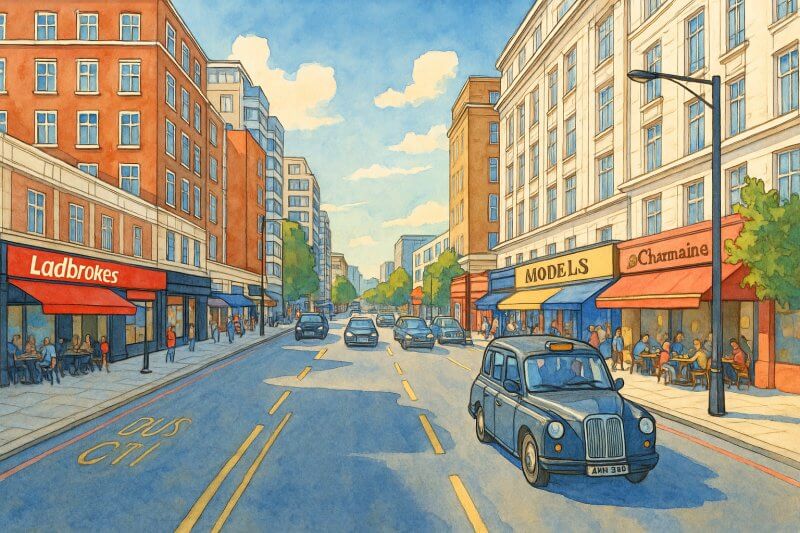
Edgware Road, London
Edgware Road: London's Historic Gateway to the North
A Storied Road That Connects Centuries of London Life
Edgware Road is one of London's most famous thoroughfares, rich in history, culture, and life. Stretching through the heart of the capital, it links central London to the suburbs and has served as a vital artery for centuries. Today, Edgware Road is known for its distinctive Middle Eastern character, vibrant street life, and important role in London’s daily flow.Where Is Edgware Road?
Edgware Road runs north-west from the busy intersection at Marble Arch, situated at the northeastern corner of Hyde Park. It extends through Paddington, Maida Vale, and Kilburn before reaching Edgware in the London Borough of Barnet. The road forms a major route out of central London, heading towards the north-western suburbs and beyond.How Long Is Edgware Road?
Edgware Road is approximately 10 miles (16 kilometers) long from Marble Arch to Edgware. However, when most people refer to Edgware Road, they often mean the central London portion, which is around 2.5 miles (4 kilometers) from Marble Arch to Maida Vale.The History of Edgware Road
Edgware Road dates back to Roman times. It was originally part of Watling Street, a major Roman road that connected London to St Albans and further north-west to Wroxeter.The route has remained in continuous use since Roman times, serving as a major exit point from London toward the Midlands and north-west England. Its significance has evolved over centuries from a Roman highway to a bustling London street known for commerce, transport, and residential life.
How Edgware Road Got Its Name
Edgware Road derives its name from the town of Edgware at its northern end. The name "Edgware" comes from the Old English "Ecgi’s weir," referring to a weir belonging to a man named Ecgi. By the medieval period, the name Edgware was firmly established, and the road leading to it naturally became known as Edgware Road. Historical references to the name date back to at least the 13th century.Map of Edgware Road, London
Connecting Roads and Major Intersections
Several important roads connect to Edgware Road along its route. Key junctions include:- Oxford Street – At Marble Arch, a major east-west shopping street.
- Marylebone Road – An important east-west link north of the West End.
- Harrow Road – Branches off at Maida Hill towards west London.
- Paddington Green – A historic green space just off Edgware Road.
Streets that connect to Edgware Road
- Aberdeen Place
- Bayswater Road
- Bell Street
- Blomfield Road
- Boscobel Street
- Broadley Street
- Bryanston Street
- Burwood Place
- Chapel Street
- Church Street
- Connaught Place
- Connaught Square
- Crawford Place
- Crompton Street
- Cuthbert Street
- Frampton Street
- George Street
- Harrow Road
- Harrowby Street
- Kendal Street
- Maida Avenue
- Marylebone Road
- Newcastle Place
- Old Marylebone Road
- Orchardson Street
- Penfold Place
- Praed Street
- Seymore Street
- St Michael's Street
- Star Street
- Stourcliffe Street
- Sussex Garden
- Upper Berkeley Street

Painting of Edgware Road (View full-size image here)
Major Buildings and Real Estate Along Edgware Road
Edgware Road is a mix of commercial and residential properties. Major buildings and landmarks along the road include:- Marble Arch – The iconic white marble monument near Hyde Park.
- Hilton London Metropole – One of the largest hotels in London, popular with tourists and conference-goers.
- Paddington Green Police Station – Historically one of the most important police stations in London for handling terrorism cases.
- Church of St Mary on Paddington Green – A historic church dating back to 1791.
The character of the street is predominantly commercial near Marble Arch, with a strong presence of retail shops, restaurants, cafés, and hotels. Further north, it becomes more residential, with tree-lined streets and mansion blocks.
Nearest London Underground Stations
Edgware Road is well served by multiple Underground stations. Note that there are two Underground stations called Edgware Road, located about 150 meters apart from each other. These two stations are distinct and not physically connected.- Edgware Road (Bakerloo Line) – Serves the Bakerloo line towards Elephant & Castle and Harrow & Wealdstone.
- Edgware Road (Circle, District, and Hammersmith & City Lines) – A separate station complex that serves three major lines, providing excellent connectivity.
- Marble Arch Station – Located at the southern end of Edgware Road on the Central Line, offering quick access to Oxford Street and the West End.
- Paddington Station – A short walk from the central section of Edgware Road, providing National Rail services, Heathrow Express, and several Underground lines.
Fun Fact About Edgware Road
A fun and little-known fact about Edgware Road is that it is sometimes called "Little Beirut" or "Little Arabia" because of its vibrant Middle Eastern community. The stretch near Marble Arch is famous for its Arabic cafés, shisha lounges, and restaurants serving everything from Lebanese kebabs to Iraqi masgouf.During the summer, especially in the evenings, the street comes alive with outdoor dining, Arabic music, and a buzzing cosmopolitan atmosphere that feels like stepping into another part of the world—all while still in central London!